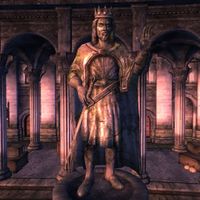Lore:Pelagius I
| Emperor Pelagius Septim I | |||
|---|---|---|---|
 A statue possibly depicting Pelagius I A statue possibly depicting Pelagius I
|
|||
| Race | Man | Gender | Male |
| Born | Second Era |
||
| Died | 3E 41 Temple of the One, Imperial City |
||
| Resided in | Imperial City | ||
| Reign | 3E 38- 3E 41 |
||
| Previous Ruler | Tiber Septim | ||
| Next Ruler | Kintyra I | ||
Pelagius Septim I was the second emperor of the Third Empire and Septim Dynasty, reigning for less than three years, from 3E 38 to 3E 41. He was preceded by his grandfather, Tiber Septim, and was succeeded by his first cousin once removed, Kintyra I.[1]
Biography[edit]
Pelagius Septim's parentage is unknown, but he was the grandson of Tiber Septim.[nb 1][1][2][3] Circa 3E 14, Barenziah came to live with the imperial family until she turned eighteen, and Pelagius reportedly came to love her like a sister.[4][5] On his deathbed in 3E 38, Tiber named Pelagius his successor, and after Tiber's death, Pelagius was crowned Emperor of Tamriel.[1][2][6][7]
According to one source, Pelagius I was initially nervous about managing all the provinces, so the Underking approached the Emperor and offered to serve as an advisor.[3] After his accession, Pelagius I reportedly viewed Barenziah with hostility, contrary to his prior friendship with her.[8] However, the Emperor had absolute trust in Barenziah's prime minister, Symmachus, who was a friend and general of his grandfather.[8] Pelagius I was as strong and resolute as Tiber, and it was believed that his reign would be a continuation of the golden age that Tamriel experienced during his grandfather's reign.[1]
In 3E 41, Pelagius I was assassinated by the Dark Brotherhood while he was praying at the Temple of the One in the Imperial City.[1][7][9] An unknown individual hired the Dark Brotherhood to assassinate Pelagius I in order to bring about a change in imperial policy.[1][9] Pelagius had no living children, so the Ruby Throne passed to his first cousin once removed, Kintyra, the daughter of Tiber's brother Agnorith.[1][7]
Notes[edit]
References[edit]
- ^ a b c d e f g Brief History of the Empire v 1 — Stronach k'Thojj III
- ^ a b Pocket Guide to the Empire, 3rd Edition: All the Eras of Man, A Comprehensive History of our History — Imperial Geographical Society, 3E 432
- ^ a b The Arcturian Heresy — The Underking, Ysmir Kingmaker
- ^ Biography of Barenziah, v 2 — Stern Gamboge, Imperial Scribe
- ^ The Real Barenziah, v 3 — Anonymous
- ^ Tamriel's Timeline, The Daggerfall Chronicles — Ronald Wartow
- ^ a b c The Third Era Timeline — Jaspus Ignateous
- ^ a b The Real Barenziah, v 4 — Anonymous
- ^ a b Amaund Motierre's dialogue in Skyrim